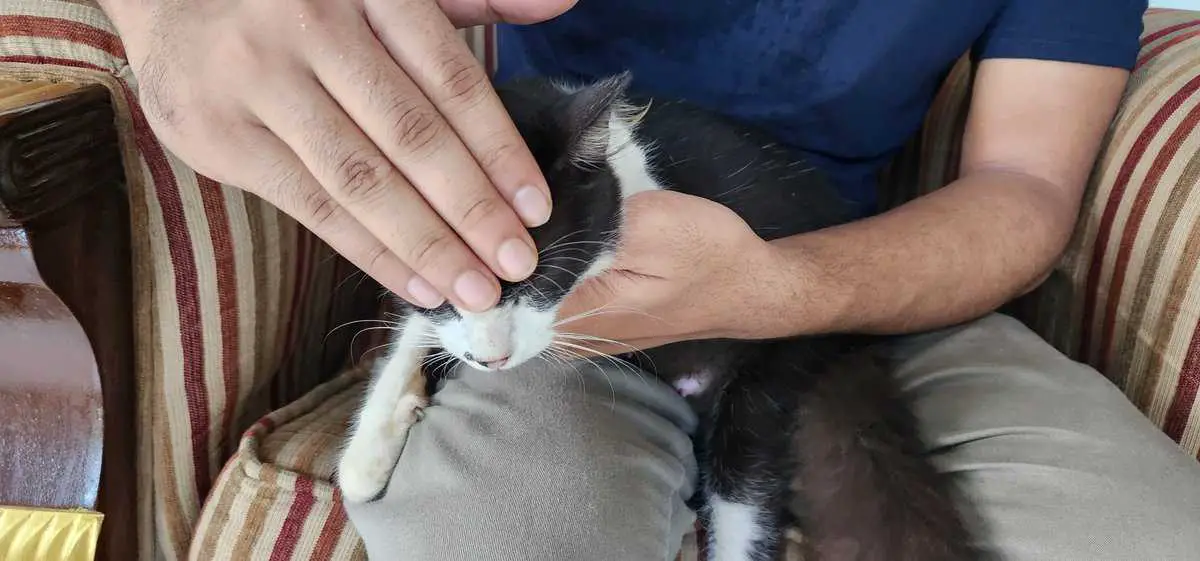I’ve had my mixed Persian cat, Muezza, for over 2 years. From what I can tell, there are a couple of instances where I stroked her only to find her head hot. It’s more likely you’re experiencing this with your feline.
So, you may be curious: Why is my cat’s head hotter than the rest of the body? From experience, if your cat acts normal, it may have to do with blood flow or brain activity. However, a hot head plus lethargy, loss of appetite, and unusual behavior may indicate fever, stress, heatstroke, or hyperthyroidism.
Let’s dive deeper as I explain the common causes of hot heads in cats and how to recognize the symptoms. I’ll also advise on what to do if your cat’s head is abnormally hot.
Why Is My Cat’s Head Hot? Uncovering the Reasons
See, here I have mentioned some reasons for cat heads to be hot for both normal conditions and unusual behavior.
| Hot But Acting Normal | Cat Hot Head and Lethargic |
| Blood flow/brain activity | Fever |
| Hot weather/basking in the sun | Stress |
| High activity/exercise | Heatstroke |
| Hyperthyroidism |
Understanding Cats’ Normal Body Temperature
Before I proceed, it would be prudent to first understand your cat’s body temperature. That way, you’ll know what is considered normal and quickly recognize if something seems off.
Your cat’s body temperature is typically 100.5 to 102.5 degrees Fahrenheit or 38 to 39.2 degrees Celsius. This higher-than-human body temperature explains why your cat feels warm to the touch.
Note that factors like age, activity level, and time of day may cause the temperature to vary. In general, however, a healthy cat should have a body temperature within this range.
Now, let’s uncover the reasons why your cat’s head feels hotter than the rest of the body. Primarily, we’ll look at two scenarios. First, your cat feels warm but acts normal. Next, your cat feels hot and is lethargic.
Reasons Cat Feels Warm But Acting Normal
Your cat may display normal behavior patterns but still have a warm head while maintaining a body temperature of 100.5 to 102.5°F. The primary explanation has to do with a cat’s blood circulation and metabolic rate. However, physical activity or simply lying in the sun or in a warm environment can be contributing factors, too.
Note that the blood vessels in your cat’s scalp and ears are particularly dense. Moreover, they’re close to the surface of the skin. So, the heat from metabolic processes easily transfers to the skin and radiates outward. This explains why your cat has a warm head and ears.
Also, studies show that smaller animals have a higher per-gram basal metabolic rate than larger animals. And the higher the BMR, the more heat is released. This explains why your cat feels warmer.
Having said that, a warmer head and normal behavior are healthy signs of blood flow and a higher basal metabolic rate. So, this shouldn’t be a cause for concern.
Reasons Why My Cat Feels Hot And Is Lethargic
Does your cat’s head feel unusually hot, accompanied by symptoms like lethargy and loss of appetite? In this case, there are four possible explanations: fever, stress, heatstroke, or hyperthyroidism. However, fever is typically the primary cause.
1. Fever:
Your cat may have a running temperature or fever. Primarily, fever is triggered to fight infections, inflammation, and autoimmune diseases. Where fever is the cause, your cat will feel hot to touch. Often, your cat is considered to have a fever if the body temperature is above 103.5°F.
2. Sunstroke or heatstroke:
Your cat will often find a cool spot from the heat of the day. However, when restrained in a hot environment, cats can get heatstroke. Persians and other cats with thick coats are particularly more prone to heatstroke.
So, your cat’s head may feel hot due to overheating, with a body temperature of 105℉. Along with excessive heat, other early signs of heatstroke are excessive panting, restlessness, drooling, and redness of the gums and tongue.
3. Stress:
Stress can cause fever-like symptoms. One of the symptoms is elevated body temperature, which may make your cat’s ears and head feel warm. Nevertheless, this is often temporary.
Still, it’s prudent that you eliminate stressors in the environment. Signs of stress in a cat are excessive grooming, lethargy, hiding, or changes in your cat’s behavior.
4. Hyperthyroidism:
An overactive thyroid gland can cause metabolism to increase and lead to persistently high body temperatures. Other symptoms of hyperthyroidism in cats include weight loss, increased appetite, vomiting, and hyperactivity.
Understanding Feline Fever: Signs and Symptoms in Your Cat
Of the potential causes I’ve discussed, I find fever to be the primary culprit. In fact, a couple of times Muezza had a hot head, and most of my vet’s diagnoses pointed to fever.
So, here I have concentrated on fever rather than other reasons. It would be prudent to discuss the signs and symptoms of cat fever.
How To Tell If Your Cat Has A Fever Without A Thermometer?
A thermometer is a good first step in determining if your cat has a fever. Nevertheless, combining thermometer readings and fever symptoms gives a more clear picture.
That being said, your cat may have a fever if it shows any of the following signs:
- Lethargy: Your cat might be more inactive than usual and less interested in playing.
- Loss of appetite: A fever can cause your cat to feel hot and not eat.
- Dehydration: A cat with a fever may drink less water, causing them to become dehydrated.
- Shivering: Just like humans, cats may shiver or tremble when they have a fever.
- Glazed or dull eyes: A cat with fever may have dull, listless eyes. Your cat’s eyes may seem glazed or not look directly at you.
- Coughing or sneezing: Other symptoms, such as coughing or sneezing, can occasionally accompany a fever.
Be aware that in severe cases, these symptoms will also include vomiting, diarrhea, and rapid breathing. Often, this calls for immediate vet attention. For the record, the normal pulse for cats is 130–140 per minute in kittens and 100–120 per minute in adults.
How to Take Your Cat’s Temperature Safely and Accurately with A Thermometer?
You want to ensure that the process is stress-free for both you and your cat. So, before you begin the process, here are a few pointers:
- Use rectal digital thermometers; they’re the most accurate.
- Pick a quiet location where your cat can relax.
- Ensure your cat isn’t agitated or distressed by giving them time to calm down.
- Avoid rough handling and unnecessary pressure on their body
Now, let’s go over the steps:
Step 1
Apply a small amount of lubricant, preferably petroleum jelly, to the tip of the thermometer. This should make insertion comfortable for your cat.
Step 2
Have someone restrain your cat and gently lift the cat’s tail.
Step 3
Insert the thermometer into the rectum. Typically, about 1 inch deep will suffice.
Step 4
Keep the thermometer inserted until you hear a beep. This may take 30 to 60 seconds.
Step 5
Note the temperature reading. The normal range should be 100.5°F to 102.5°F. If you get a higher reading, your cat has a fever. Fevers over 105°F are especially considered dangerous for your cat.
Step 6
Use rubbing alcohol to disinfect your thermometer after use.
Here’s a video for guidance:
What to Do If Your Cat Is Suffering From Fever?
An occasional temporary fever in cats may resolve spontaneously. However, it’s not advisable to just monitor the situation. Here are some at-home tips to help:
- Keep your cat comfortable, providing a warm and cozy place to rest.
- Limit stress by choosing a quiet environment and minimizing excessive handling.
- Ensure access to fresh water at all times as dehydration often worsens the effect of fever.
- Offer palatable, easily digestible foods like canned tuna that will tempt them to eat.
If there’s no noticeable improvement in appetite and energy level, take your cat to the vet. It’s true that antibiotics like amoxicillin and anti-inflammatory drugs like corticosteroids typically treat cat fever. Nevertheless, the specific treatment plan for your cat’s fever will depend on the cause, severity, and other factors.
Having said that, your vet will determine the best approach based on a physical exam, diagnostic testing, and your cat’s medical history. In most cases, your vet will typically prescribe antibiotics, specifically Amoxicillin. But they may also prescribe anti-inflammatory medications and supportive care.
What to Do If the Reason Is Heatstroke, Stress or Hyperthyroidism?
We’ve discussed the symptoms of heatstroke, stress, and hyperthyroidism in cats. But what steps should you take if your cat experiences any of these issues?
Heatstroke Treatment
Step 1: Remove your cat from the hot environment immediately.
Step 2: Spray lukewarm water on your cat’s fur and put her in front of a fan set to low to maximize heat loss.
Step 3: After 10-15 minutes of fanning, take your cat to the vet even if it seems to have recovered.
Stress Treatment
Have a safe space for your cat away from stressors like noise. Besides food, water, and a litter box, provide enough toys and enrichment items.
Natural pheromone spray for felines will also come in handy. The Feliway spray for cats is a good example. It will calm down your stressed cat by comforting and reassuring them all is well.
You can also take your cat to the vet. Typically, the vet will prescribe anti-anxiety medication like antidepressants. It will help your cat relax and cope.
Hyperthyroidism Treatment
Felimazole is the best treatment for hyperthyroidism in cats. You should give these oral tablets after every 12 hours. Even at that, you’ll only get this drug via vet prescription. So, you’ll have to take your cat to a licensed vet for a proper prescription.
FAQs
Before we wrap up, let’s answer popular questions related to the topic.
Q. Can I give paracetamol to my cat?
Paracetamol is highly toxic to cats. Also known as acetaminophen, paracetamol triggers fatal reactions as a cat’s liver doesn’t have the enzyme Cytochrome P450 to break it down.
Q. Can I give my cat human medication for fever?
No. Medications that seem safe for humans can be toxic to cats. So, only give medications formulated for cats. Even then, you shouldn’t do it without explicit instructions from a vet.
Q. How much amoxicillin do you give a cat?
Amoxicillin is a common antibiotic for cats with a daily dosage of 50 mg or 5-10 mg/pound. Nevertheless, it’s dangerous to give your cat amoxicillin without vet’s prescription.
Conclusion
Several reasons may explain why your cat’s head feels hotter than usual. It’s true that some are harmless, like blood flow and basking in the sun. Nevertheless, others could be more concerning, like fever, stress, heatstroke, and hyperthyroidism.
Be that as it may, it’s always best that you err on the side of caution. Primarily, you want to watch out for symptoms like lethargy, loss of appetite, and changes in behavior. If any, consult with your veterinarian. Early intervention will ensure your cat receives prompt treatment to prevent any potential health risks.


Leave a Reply